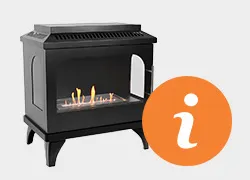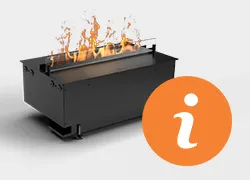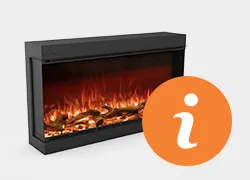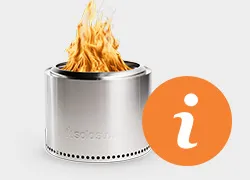Bioethanol Fireplace FAQ
What is a bioethanol fireplace?
A bioethanol fireplace uses bioethanol fuel to burn. Bioethanol fuel is a renewable energy source derived from organic material such as potatoes, corn, and sugar cane. A bioethanol fireplace doesn't require a chimney or flue and they don't produce smoke, soot, or ash, which makes it an eco-friendly solution - BUT the flame is real! Our bio fires come in a variety of designs and models, such as traditional mantel design, log burner style, suspended, wall mounted - you name it!
Need more information? You can read all about bioethanol fireplaces here and how they work.
What are the different types of bioethanol fireplaces?
There're a variety of different types of bioethanol fireplaces! Bioethanol stoves, traditional bioethanol fireplaces, suspended bioethanol fireplaces, wall mounted ethanol fireplaces, and we could go on and on...
See our large selection of bioethanol fireplaces and get inspired.
How do I refill my bioethanol fireplace?
It's necessary for a bioethanol fireplace to be filled with bioethanol fuel to burn. The process for filling in bioethanol fuel can vary from fireplace to fireplace and always depends on the type of burner you have. But before you start filling your burner, it's important to check the fuel! Make sure that you always opt for a high quality bioethanol fuel with an alcohol percentage of 95-97.5%.
Read the guide here to learn more about how to fill your bioethanol fireplace with bio ethanol fuel.
How do I light and extinguish a bioethanol fireplace?
It's relatively easy to light a bioethanol fireplace. Simply fill in the fuel in the opening of the burner where the flame comes from, and light it with a lighter. At the beginning of burning the flames will always be a bit blue-ish and small, but don't worry - after a couple of minutes, the flames will be beautiful. Read more and see a couple of videos of how to light a bioethanol fireplace here.
However, lighting a manual bioethanol fireplace is different from lighting an automatic bioethanol fireplace. Read more about the difference between manual and automatic burners here.
Extinguishing a bioethanol fireplace also depends on whether it's manual or automatic. If it's a manual fireplace, you slide the metal top plate over the flame using your extinguishing tool. If it's an automatic bioethanol fireplace, you simply press 'stop' using the remote control or control panel. Read more here about how to extinguish a bio fireplace.
Does a bioethanol fireplace produce heat?
Yes, it does! However, it's important to state that a bioethanol fireplace cannot function as a primary heat source, but it's possible to supplement the existing primary heat source.
The heat output varies from fireplace to fireplace and external factors such as room size, insulation and ventilation can also influence the heat effect as well. However, bioethanol fireplaces can provide decent amounts of heat, averaging from 2-5 kW. You can read lots more about it in the guide here.
Are bioethanol fireplaces safe?
Yes, absolutely! However, there are a few rules that need to be followed when operating a bio ethanol fireplace but if these rules are followed, a bioethanol fireplace is safe to use and operate. If you want more information on how to operate a bioethanol fireplace, see here.
You can also read this guide that explains the safety of bioethanol fireplaces.
Do I need a flue or chimney with a bioethanol fireplace?
Nope! It's not necessary to connect a flue or chimney to a bioethanol fireplace. Bio fires are designed to burn bioethanol fuel in a very clean way, and they only produce small amounts of water vapour and carbon dioxide. Therefore, a flue or chimney is not necessary which make them a great solution for your home without extensive modifications. What's not to like?!
Can I convert my traditional log burner fireplace into a bioethanol fireplace?
Absolutely you can! It's actually really easy and a lot of our customers choose to convert their existing fireplace into a bio ethanol fire, and we always love it as a bio ethanol fire can bring back life to an old fireplace that's no longer in use.
When converting an existing fireplace to a bioethanol fire, we always recommend to close off the chimney to avoid drafts and to make sure that the heat the burner generates stays inside the room instead of escaping into the chimney.
There're a lot of options when it comes to converting an existing fireplace. You can insert a bioethanol fireplace insert in your existing grate or basket, but you can also remove the insert and install a bioethanol built in insert.
You can also read our guide how to turn a traditional fireplace into a bio fireplace and get inspired by the videos on the page.
How do I install a bioethanol fireplace?
That depends on the fireplace! However, it's relatively easy and straightforward to install a bioethanol fireplace.
See a few examples here of how to install a wall mounted bioethanol fireplace and how to install a freestanding bioethanol fireplace.
Bioethanol fireplace safety distance
It's important to be careful and follow the simple rules and safety distances of a bioethanol fireplace. It's mainly the distance to combustible materials and distance above the fireplace that's important. We always recommend to have a safety distance of 100 cm to combustible materials and 100 cm clearance above the fireplace. You can read more about bio ethanol fireplace safety distance here.
Other rules apply when inserting a bioethanol fireplace, and it's important to follow the provided guides and manuals when building in a bioethanol burner or fireplace. Read more here about how to place and install a bioethanol fireplace.
What kind of fuel should I use?
Bioethanol fuel is not just bioethanol fuel. This is why we always recommend our customers to use a good quality bioethanol fuel. The bioethanol fuel should always have an alcohol percentage between 95 and 97.5%. This is really important, as the alcohol percentage, and quality of the fuel in general, determines how it burns, the burn time, what the flame looks like, the smell, etc.
It's therefore important that you never compromise when purchasing bioethanol fuel for your fireplace.
You can read and learn more about the fuel here.
See our top quality bioethanol fuel with an 96.6% alcohol percentage.
Does bioethanol fireplaces smell?
No, they don't smell. There'll always be a slight smell at the beginning when you just ignite your fireplace and at the end when it's burning out or you extinguish the fire.
However, the quality of the fuel is really important and plays an important role. It's therefore really important to get bioethanol fuel with an alcohol percentage between 95-97.5% alcohol. If the alcohol percentage is either higher or lower than the recommended alcohol percentage it can cause a bad smell and burn of the fuel.
Should you have any questions in this regard, please reach out to our team, who'd be happy to provide you guidance.
Can you put a TV above a bioethanol fireplace?
We always recommend to follow this guide on how to install a TV above a bioethanol fireplace.
Do you have a design in mind that doesn't necessarily follow the example in the guide, reach out and we'd be happy to provide you guidance of how to construct and install a bioethanol fireplace to fit your design ideas.









